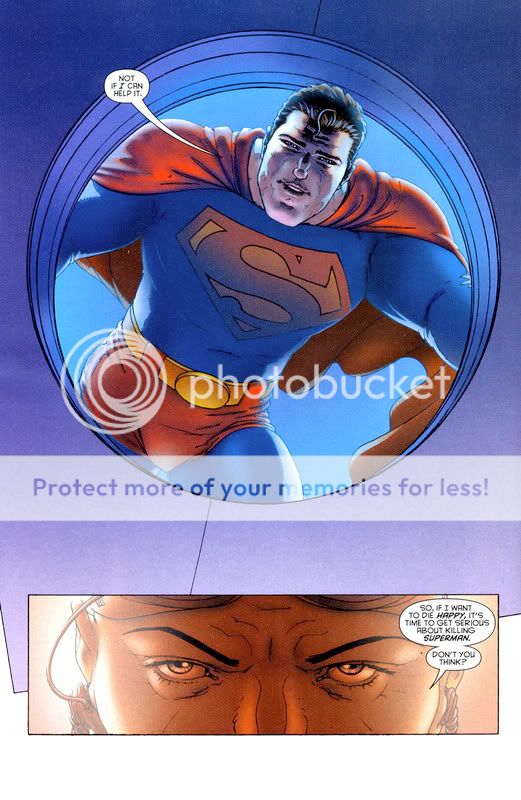A while back I talked about All-Star Superman and why I thought the first 8 issues or so weren’t as great as they were cracked up to be. Several folks argued that I’d be more impressed if I finished the series.
So I just reread issues 1 to 12 and…eh. It’s not terrible or anything, certainly. I appreciated Frank Quitely’s art more this time around than I have in the past. The series has a nice, bright, striking color palette, and I like the clarity of the linework and layout; there’s a touch of Winsor McCay there, I think. I still find his figure drawings and faces off-putting; his women in particular often look like uncomfortably slender fetish mannequins, and facial expressions seem rubbery and oddly unexpressive. But as far as mainstream art these days go, this is about as good as it gets, I think.
The story is fine too…Morrison keeps things humming along; there’s no shortage of nutsy throwaway ideas — using a gravity gun to warp time; descendents of dinosaurs living underneath the earth; Jimmy Olsen dressing in Kryptonian garb for a lark; underworlds, overworlds, shrunken super-doctors — it’s all good. And, of course, there’s Superman’s approaching cell-death hanging over the series, giving it weight and pathos.
Except…man, how much do I care about these folks at all? Jimmy Olsen for example; he’s hip, he’s incredibly resourceful, he’s got this sixth sense which warns him of danger, he’s got his signal watch — he’s just so cool! And, well, irritating. Same with the endlessly chattering Lois who won’t believe Clark is Superman; or with Superman himself, always rushing off to save someone or other, constantly forgiving everybody; or with, say, Lex’s gratuitously fetish-goth-garbed niece. Everything’s just. So. Awesome! and. Inventive! and Cool! “No one but me can save the world Lois! My cells are converting to pure energy, pure information. And I only have moments to save the world.” Tum ta tum! You feel like you need to utter a little inspirational horn bleat after every panel; it’s all characters making preposterously pompous little speeches and the racing off to be heroic. Everything feels like it’s at maximum volume.
Morrison’s always written like that. In stuff like Doom Patrol or even the Filth, I always felt it was thrown off tongue in cheek; making fun of the immensity of super-hero stuff, and often undercutting it with pratfalls or ridiculousness (like the silly Brotherhood of Dada, for example.) But as he’s moved into more mainstreamy work, that deflation has gotten lost. And…it’s not that he’s not clever. It’s not that he doesn’t have good ideas. It’s not even that there aren’t touching moments. I just hate the feeling that he’s tapping me on the shoulder every page yelling in my ear, “This is soooo great! This is Superman, booooy! Go! Go! Go!”
I’ve said this before, but…it totally vitiates everything that’s best about Silver-Age storytelling when you try to tell a story capturing the brilliant innocence of silver-age storytelling. Because a lot of what was fun in those Silver-Age stories was that they were really off-hand and not at all pretentious. Sure, a Silver Age story might have Bizarro in one panel and evolved dinosaurs in the next and then an intelligent sun on the next page…but that would just be the story. There wouldn’t be the winking about, wow, this is so cool. I felt like Alan Moore handled it better in “Whatever Happened to the Man of Tomorrow” by slowing the pacing down and being somewhat more bloody minded; trying to think how the silver age stuff might work out if you looked at it from an older perspective. It was an homage to the era, not an attempt to recreate it. Morrison though seems to be trying to go back in time through sheer puffery and volume and frantic pacing. And I think it’s significant that Moore’s message was that the world doesn’t need Superman (which is, as it happens, true), whereas Morrison’s message is that we do need Superman watching over us forever, at least as a kind of beautiful ideal. Which is basic fanboy aggrandizement — and also not true, even if you bellow it.
Also, the end? I really thought, from all the foreshadowing and what people had said about the series that, you know, he dies. But he doesn’t quite. They still think he might come back. It just seems…I don’t know. It seems kind of lame, really, with all the build up.
Again, I didn’t hate the book. It’s entertaining. There are a lot of wonderful moments (Clark Kent bumbling around while interviewing Lex Luther is lovely; reminded me of the Chris Reeves Superman movie, which I still think was pretty great.) And of course, it’s hard to resist Luthor’s eyes checking out the superpackage:
I know everybody goes on about the freshness of the series, the way it rejuvenated the character, and on and on. But it feels really decadent to me; definitely part of the zeitgeist, rather than an answer or alternative to it. I’d way, way, way rather read this than Marvel Zombies…but I don’t necessarily think they’re different in kind.

